





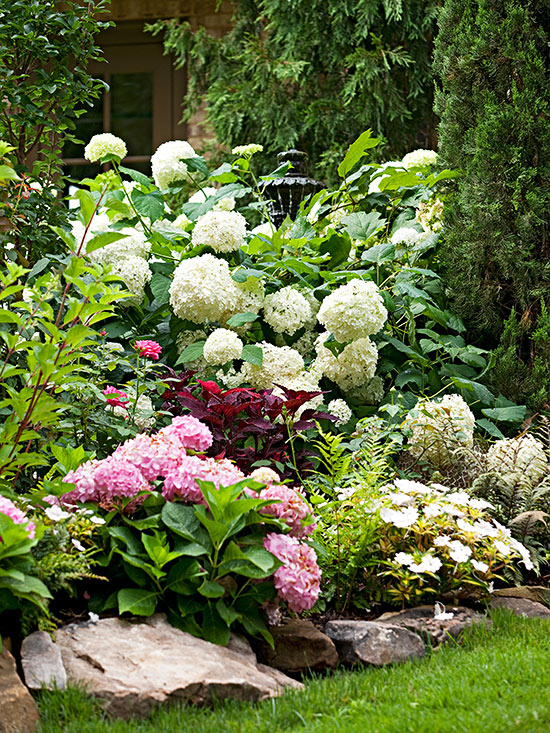
Saving seeds of most hybrid annuals is a thankless task because not all of next year's flowers will be up to the standards of this year's cultivars; each year they will either get smaller in size or lose much of their color, or both. And it's impossible to tell which seedlings will be acceptable until they bloom (although some cultivars such as Nicotiana "Lime Green" will flower true to type).
continue reading belowMost of the annual seeds can be gathered, placed in paper envelopes, carefully labeled, then stored in a cool, dry, dark place until they are needed the following spring. All the annual ornamental grasses are perfect for seed saving, as well as bishop's weed, winged everlasting, borage, creeping zinnia, tithonia, Johnny-jump-up, bells-of-Ireland, most tree mallows, California poppy, and starflower.
The end of summer is the time to watch for ripening seedpods to be dried for winter bouquets. It's the time of the year when flowers seem to sense the approach of cool weather and often burst forth with a last round of bloom. The colors seem brighter against the sharp blue skies that appear as temperatures fall and the air trades that misty softness of summer for the crystalline clarity of autumn.
As the days grow shorter you will be surprised by the strength of some of your annuals. The leaves of the various strawflowers (many have their origins in Australia) may shrivel with the increasing cold of autumn, but their stiff petals of bright orange, red, yellow, or white resist the advances of frost, continuing to glow in the morning sun of early fall. The flowers of the poppy may be gone, but the marvelous seedpods are still there. Fall brings out the glorious colors of the flowering cabbages and kales, plants that need the nip of frost not only to grow but also for their colored leaves to shine. Then there are the pansies; they'll bloom all winter in areas of the country where winters are mild, but will even persist in northern gardens until almost the end of the year, or until snows get too deep for casual walks to the garden. Sweet alyssum, too, will keep flowering far into fall.
This is the time of the year to think about moving some of the geraniums (Pelargonium spp.) into pots and taking them indoors to a sunny windowsill for winter bloom. Some annuals, such as bedding begonias or ageratums, can be dug up and placed in small pots, where they will continue to produce flowers until the very short days of December. Polka-dot plants (Hypoestes phyllostochya) are really tropical perennials and are easily moved to indoor pots for the winter. Even marigolds will fight the advancing seasons and bring a spot of gold to the living room.
Learn plants to add to your garden in autumn.
Older garden books advise pulling geraniums from the garden in fall, shaking off the dirt, and hanging them in a frost-free place for winter's duration. In spring the plants are cut back and replanted. You may want to try this method -- sometimes it works and sometimes it doesn't. When you realize the savings that could be applied to other plants in the coming season, it may well be worth the effort.
If you have a greenhouse, a sunporch, or room in the basement for a light garden, you can take cuttings of many annuals to start new plants.
Where winters are cold, tender bulbs must come out of the ground in fall to be stored indoors. Dig up dahlia tubers after the first frost has blackened their leaves. Cut off the stems a few inches above the circle of tubers, remove as much soil as you can, and let them dry for a few days. Then you can brush off the remaining soil. Sort the tubers according to flower color, and store them in paper bags or boxes in a cool, dry place until the following spring. Save gladiolus corms in the same manner, and don't forget to dig up the large black tubers of four-o'clocks (Mirabilis jalapa), as well as the thick rhizomes of all the cannas.
1. Cut healthy stems about 3 to 5 inches long using a sharp, clean knife or razor blade, slicing just below the point where a leaf stalk joins the stem.
2. Remove any damaged leaves and flowers, and neatly cut off any bottom leaves.
3. Fill a seed flat or some pots with dampened sterile soil or a potting mix. Tamp it down, then make a hole with a pencil to three-quarters of the pot's depth.
4. Insert the cutting, making sure that the base of the stem is in contact with the dirt at the bottom. Then firm the soil around the stem.
5. Put the potted plant in a plastic bag with the opening at the top. Seal the bag with a twist of wire to create a tiny greenhouse. Put the container in bright light but not direct sun.
Keep the soil moist but never soggy. In about two to three weeks, give the cutting a slight tug to check if rooting has commenced. If it hasn't, pull out the cutting to see if the end has started to rot. If everything looks healthy, try again, but make doubly sure that the stem bottom is in contact with the soil; it needs this stimulus to start new roots. You may wish to dip the end of the cutting in rooting hormone powder as well.
You can also root cuttings of some annuals in a glass of water. Impatiens, coleus, begonias, and geraniums will soon begin to produce roots. After a number of roots begin to appear, start adding small amounts of sand or soil to the water every few days. That way you won't have a tangled mass of roots to sort out when it's time to transplant, and the soil or sand will stimulate the roots to grow new root hairs, which are the true movers of food and water to the plants.
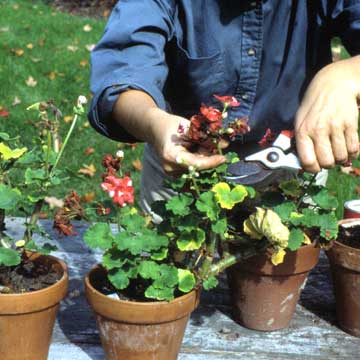 Step 1
Step 1
1. As summer ends, you can take cuttings of geraniums and other annuals to root for winter houseplants. First clip off the flower heads.
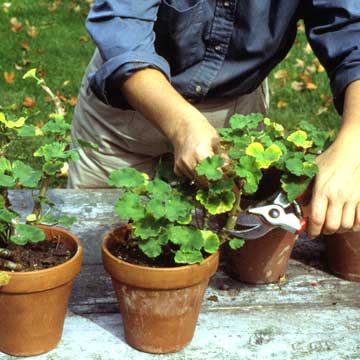 Step 2
Step 2
2. Select healthy shoots to use as cuttings. Young, vigorous growing tips or side shoots make the best cuttings for indoor plants.
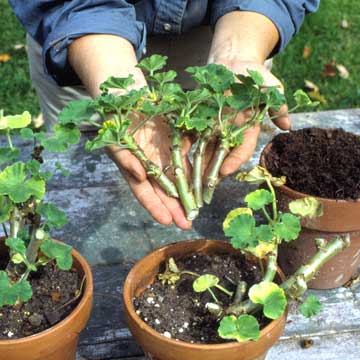 Step 3
Step 3
3. Remove the leaves from the bottom third or half of each cutting, as shown here. Have pots full of moist potting mix ready for planting the cuttings.
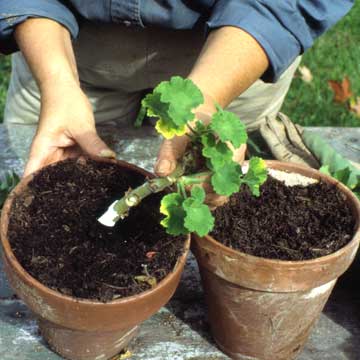 Step 4
Step 4
4. Dip the end of each cutting in rooting hormone powder if you like (they will also root without it), and insert each into the potting mix almost up to the lowest leaves.
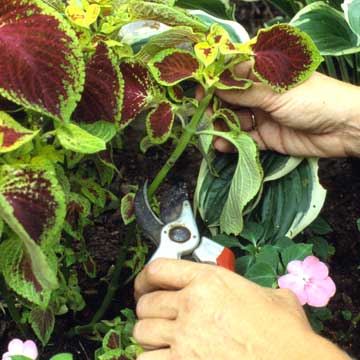 Step 1
Step 1
1. Coleus makes a colorful houseplant. In late winter you can take cuttings from the indoor plants and root them to have new plants for the garden.
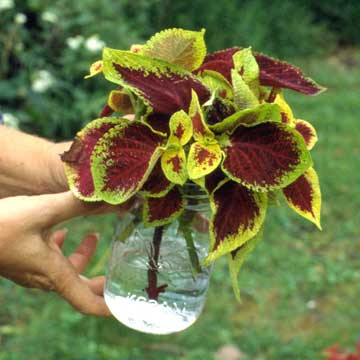 Step 2
Step 2
2. Coleus cuttings root quickly in water. Strip off the lower leaves, and insert the stems into water. Change the water once or twice a week so that bacteria won't build up.
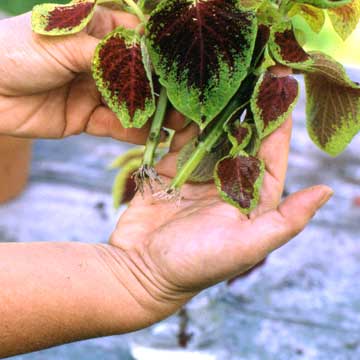 Step 3
Step 3
3. In a matter of weeks the coleus cuttings will develop good roots. Once you get a good assortment, you can plant the cuttings in pots.
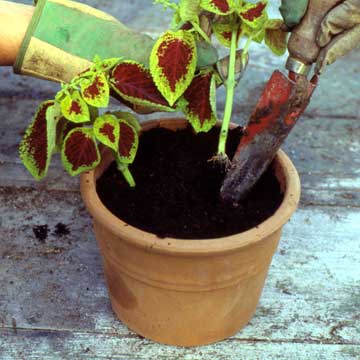 Step 4
Step 4
4. Plant the rooted cuttings in a light, porous but moisture-retentive potting mix. Handle them carefully during planting to avoid injuring the delicate roots.
After saving as many annuals as you can and safely storing the bulbs and tubers for the coming spring, there is still cleanup work in the garden. Perhaps you have collected some bushel baskets or plastic trash bags that are full of leaves that fell from your or your neighbor's trees. After shredding, either add them to the compost heap or, using a small cultivator, mix them into the garden soil so that they can decay over the winter and grace the soil for spring.
Before the temperatures really plummet, pull out all the dead plants, carefully shake off all the dirt you can, and move them to the compost heap. At the same time, take care of those late-growing weeds. Then carefully rake the soil, and neaten up the edges. Clean the dirt off your garden tools. Wind up the garden twine, and wash your garden gloves. Clean and coil the hoses, and collect all those labels that now dot the garden. Then go indoors, make a good cup of tea or coffee, gather your new seed catalogues, and get ready for the wonderful year ahead.
Copyright © www.100flowers.win Botanic Garden All Rights Reserved